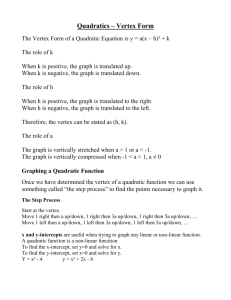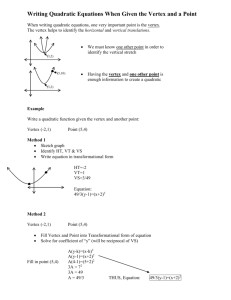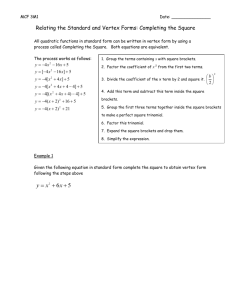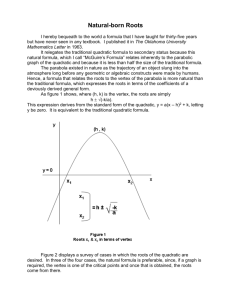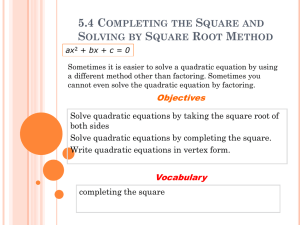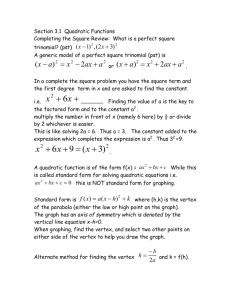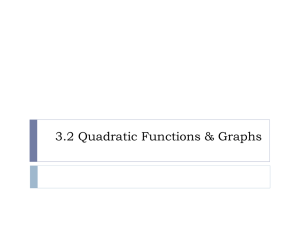Graphs of Quadratic Functions
advertisement
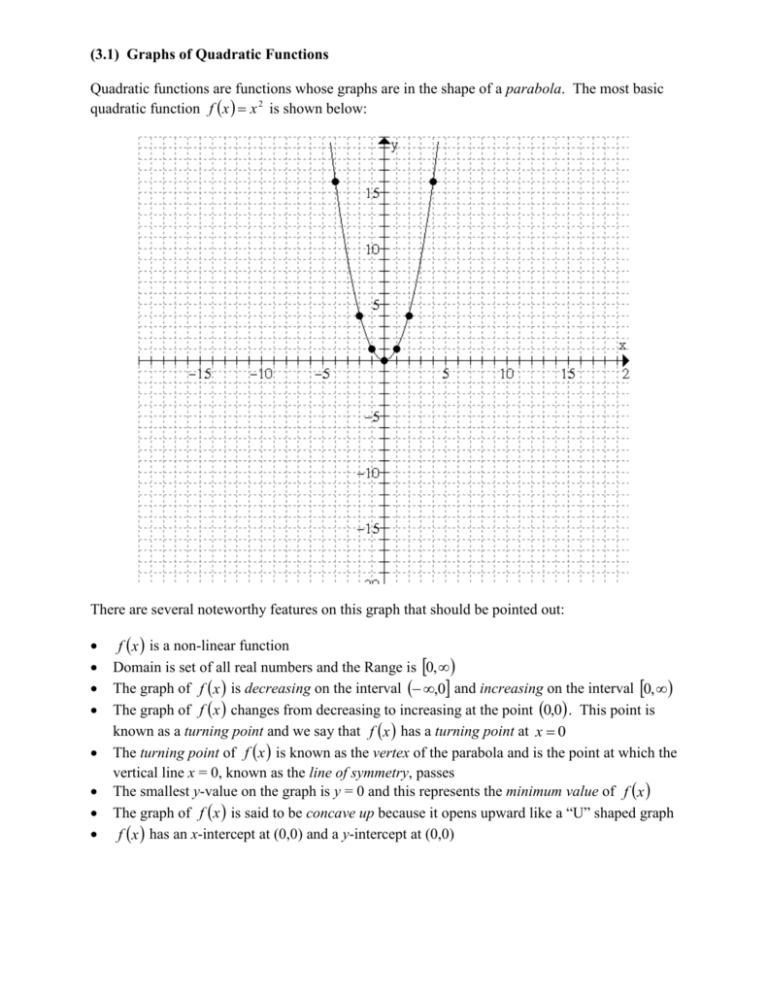
(3.1) Graphs of Quadratic Functions Quadratic functions are functions whose graphs are in the shape of a parabola. The most basic quadratic function f x x 2 is shown below: There are several noteworthy features on this graph that should be pointed out: f x is a non-linear function Domain is set of all real numbers and the Range is 0, The graph of f x is decreasing on the interval ,0 and increasing on the interval 0, The graph of f x changes from decreasing to increasing at the point 0,0 . This point is known as a turning point and we say that f x has a turning point at x 0 The turning point of f x is known as the vertex of the parabola and is the point at which the vertical line x = 0, known as the line of symmetry, passes The smallest y-value on the graph is y = 0 and this represents the minimum value of f x The graph of f x is said to be concave up because it opens upward like a “U” shaped graph f x has an x-intercept at (0,0) and a y-intercept at (0,0) Graphing Quadratic Functions Using f x x 2 as your base graph sketch graphs for each of the following functions: 1 f x 4 1 4 Concavity: Domain: Range: Intercepts: Vertex: y 2 f x 3 4 Concavity: Domain: Range: Intercepts: Vertex: y Vertex Form: f x a x h k -- Each of the functions you graphed in the preceding exercise were of the form y af x h k or using our base graph of f x x 2 we have 2 y a x h k , where h and k are constants. 2 1. What effect did the constant a have on your graph? Explain. 2. What effect did the constant h have on your graph? Explain. 3. What effect did the constant k have on your graph? Explain. 4. What is the vertex for a quadratic function written in vertex form: f x a x h k ? 2 Standard Form: f x ax 2 bx c where a 0 Simplify each of the two quadratic functions you were given to graph earlier as much as possible. y 1 x 4 2 1 4 y 2x 3 4 2 Vertex Form vs Standard Form f x a x h k o Parameters: a affects concavity AND vertically stretches and compresses graph h shifts graph left or right AND is the x-coordinate of the vertex k shifts graph up or down AND is the y-coordinate of the vertex f x ax 2 bx c where a 0 o Parameters: a affects concavity (we’ll learn more about b and c and their impacts later) 2 We already know how to take a quadratic function that is in vertex form and express it in standard form. How do we take a quadratic function already in vertex form and express it in standard form? Going from Standard Form to Vertex Form Simplify the expression: a x h k 2 Take the expression you got above and set it equal to ax 2 bx c , equating the x 2 -terms with each other, the x-terms with each other, and the constant terms with each other. Find expressions for h and k. Factoring Quadratic Functions: f x ax p x q It is sometimes useful for our discussion of quadratics to be able to write them in factored form. One reason is that we can quickly determine the x-intercepts by setting each product equal to zero. Another reason is that there are some real world applications in which one quantity is a product of two other quantities and these two quantities behave linearly. You will notice that in the above factored form the two factors x p and x q are both linear and their product together determines a quadratic function. Factoring is a very special process and it is very rare for a quadratic function to factor as nicely as say the function f x 2 x 2 7 x 5 2 x 5x 1 does. When a quadratic function does factor like the one shown above, we say that it has been factored. More generally, we would sometimes like to be able to take a function like f x ax 2 bx c and factor it: f x mx p qx r where m, p, q, and r are all constants. What this means for a quadratic functions written in standard form is that we would like to be able to find m, p, q, and r given f x ax 2 bx c so that it is equal to f x mx p qx r . Let’s see if we can find out anything special between the standard form of a quadratic and its factored form: ax 2 bx c mx p qx r mqx 2 mr pq x pr Equating corresponding terms we have the following relationships: a mq b mr pq c pr It would be very tedious to have to solve three equations at the same when looking for four constants. Perhaps we can look at our three equations in some other way. For instance, notice that b is made up of the sum of two numbers, mr and pq and these numbers are each factors of ac = mqpr. If we can find numbers that multiply to ac and add to b then we will be able to find m, p, q, and r. Let’s try this on f x 6 x 2 13x 5 . First, let’s list all the pairs of numbers that multiply to -30 and then we can find the right combination that adds up to -13: 1,30 1,30 2,15 3,10 5,6 2,15 3,10 5,6 The only one that adds up to -13 is (2,-15). This tells us: mr 2, pq 15 or vice versa (it doesn’t matter) so: 6 x 2 13x 5 6 x 2 2 15x 5 6 x 2 2 x 15 x 5 6 x 2 2 x 15 x 5 2 x 3x 1 53x 1 3x 12 x 5 2x2 9x 4 Try factoring: 6 x 2 7 x 20 12 x 2 13x 4
